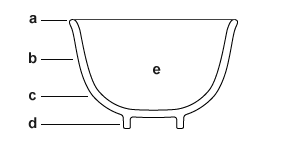|
||
 |
||
1@A generic term for ceramic wares called toujiki ©₯ν from the 9 - 16c. Initially used for tea drinking and considerably later for rice.
2@A ceramic bowl used for drinking tea at a tea ceremony. Japanese chawan are most frequently used but those imported from China and Korea are also favored. The tea bowls imported from China are called *karamono ¨ (to referring to the T'ang dynasty). Korean bowls are called kourai chawan νq and Japanese tea bowls are called *kuniyaki Δ, meaning domestically fired. The type of chawan used depends on whether the ceremony is formal shin ^, semi-formal gyou s, or informal sou . See *shin-gyou-sou ^s. One of the most formal chawan used since ancient times, is a tenmoku bowl *tenmoku jawan VΪq. which has a unique shape: a wide top, and a special oil-spot glaze of Chinese lineage. Today, it is used only when accompanied by a large portable shelf *daisu δq, and a wooden saucer called *tenmokudai VΪδ. In Japan, however, chawan of plainer design and irregular shape are appreciated more than those with such perfect forms, especially at a simple, quiet tea ceremony. Thus, many domestic tea bowls came into use in the late 16c. Their type and design are extremely diverse, and made even more so by the preferences of tea masters. In general, a bowl shaped for easy drinking is most appreciated. The average size is 15cm in diameter at the rim and about 8cm high. In the summer, a shorter bowl is favored, while in winter, a barrel-shaped bowl about 10cm in diameter at the rim
Aside from the tenmoku type introduced in the Muromachi period, and one of Korean lineage which was a deep bowl called idojawan δΛq, the most popular bowl was a domestic type called *rakuyaki yΔ. It appears to have been introduced by Sen Rikyu ηx (1502- 91). Generally, tea bowls are appreciated for the shape of the rim, kuchi-zukuri ϋ’, the inside of the bowl, mikomi ©, the body of the bowl, dou ·, and the foot, koudai δ. By the mid-18c, a middle grade of green tea called sencha χ gained in popularity and smaller sized tea bowls came into use.

a) kuchi-zukuri ϋ’@b) dou ·@c) koshi
d) koudai δ@e) mikomi ©
d) koudai δ@e) mikomi ©
@
(C)2001 Japanese Architecture and Art Net Users System.@No reproduction or republication without written permission.
fΪΜeLXgEΚ^ECXgΘΗASΔΜRecΜ³f‘»E]ΪπΦΆά·B

